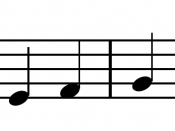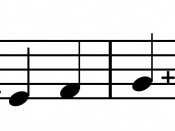Pythagorean vs. Equally Tempered
In the western world of music, there is a commonly used system of tuning for an instrument, called equally tempered tuning. However, this was not always the system in use. Before equal tempered tuning, there was the Pythagoras scale, developed about 2,500 years ago by Pythagoras. Although Pythagoras' scale sounded very natural, it had a flaw. Over time, more complex instruments were created that could reach higher octaves, where the flaw became too obvious to ignore. While equal tempered tuning fixed the error, some qualities were also lost. To understand both of these systems and their differences, we must first have a basic understanding of sound.
Sound is energy. When something creates sound vibrations, it makes molecules in the air vibrate (longitudinal waves), which then travel to the ear and vibrate the ear. These vibrations are then interpreted by the brain as sound. Different sounds have different shapes, velocities and pitches.
The velocity of sound refers to the strength with which the sound is created. Pitch refers to the frequency or rate of vibration. If something is high pitched, it has a high frequency, meaning it vibrates the air at a higher rate, and a low pitch vibrates at a lower rate. Different sound interpreters have different frequency ranges. For example, humans can hear sounds ranging from 20Hz to 20kHz. However, dogs can hear sounds at 50 kHz or higher. This is why dog whistles cannot be heard by humans, but can by dogs; because their frequency is above our hearing range, but still within that of dogs.
Discovered around 530 BCE, Pythagoras' Scale was a very natural sounding scale. It was first discovered, when Pythagoras realized that when you pluck two strings of a certain ratio to each other, it makes a...


